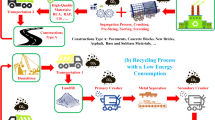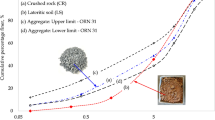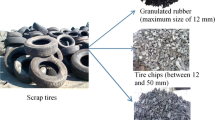Abstract
Sustainable programs are increasingly stimulating the use of industrial wastes, minimizing economic and environmental impacts. This use is especially notable in the mining industry, in which the amount of discarded material is exaggeratedly higher than the amount of obtained product. In this context, the aim of this paper is to study the sandy wastes generated from beneficiation processes of scheelite (CaWO4) to determine its potential use as a raw material in pavements. First, a physical, chemical and mineralogical characterization of the sandy wastes was performed. Subsequently, geotechnical characterization tests (grain size analysis, specific gravity, compaction, CBR and direct shear) were performed. The waste presented a heterogeneous mineralogical composition which is consistent with the mineralogical composition of the scheelite host rocks. The main minerals are calcite, quartz, micas and silicates of the garnet group and the pyroxene group that commonly occur in calcium-rich metamorphosed sediments. This resulted in a sandy and non-plastic material, positively influencing the geotechnical behaviour. The results show that the residual strength envelope exhibits zero cohesion for compaction energies, but the residual friction angle increases with the increasing energy. The values obtained for the strength parameters indicate that this material can be used as road embankment layers.









Similar content being viewed by others
References
ABNT (Brazilian Association of Technical Standards) (2016) ABNT NBR 7182:2016: Soil: compaction test. Rio de Janeiro
Agyeman S, Ampadu SI (2015) Exploring the techno-economic feasibility of mine rock waste utilisation in road works: The case of a mining deposit in Ghana. Waste Manag Res 34(2):156–164
Ahmed A, Abouzei AZM (2009) Potential use of phosphate wastes as aggregates in road construction. J Eng Sci 37(2):413–422
Amrani M, Taha Y, Kchikach A, Benzaazoua M, Hakkou R (2019) Valorization of phosphate mine waste rocks as materials for road construction. Minerals 9(4):237. https://doi.org/10.3390/min90402
ASTM (2008) D3080M: Standard test method for direct shear test of soils under consolidated drained conditions. ASTM International, West Conshohocken
ASTM (2012) D1557-12e1: Standard test methods for laboratory compaction characteristics of soil using modified effort (56,000 ft-lbf/ft3 (2,700 kN-m/m3)). ASTM International, West Conshohocken
ASTM (2012b) D698-12e2: Standard test methods for laboratory compaction characteristics of soil using standard effort (12 400 ft-lbf/ft3 (600 kN-m/m3)). ASTM International, West Conshohocken
ASTM (2014) D854-14: Standard test methods for specific gravity of soil solids by water pycnometer. ASTM International, West Conshohocken
ASTM (2016) D1883-16: Standard test method for California bearing ratio (CBR) of laboratory-compacted soils. ASTM International, West Conshohocken
ASTM (2017a) D6913/D6913M-17: Standard test methods for particle-size distribution (gradation) of soils using sieve analysis. ASTM International, West Conshohocken
ASTM (2017b) D4318-17e1: Standard test methods for liquid limit, plastic limit, and plasticity index of soils. ASTM International, West Conshohocken
Ayan V, Khavandi A, Omer JR, Limbachiya MC (2016) Toughness performance of recycled aggregates for use in road pavement. Int J Transp Eng 3:3
Bareither CA, Benson CH, Edil TB (2008) Geological and Physical factors affecting the friction angle of compacted sands. Can Geotech J 45:1224–1236. https://doi.org/10.1139/T08-058
Blight G (2011) A handbook for management waste. Chapter 5—Mine waste: a brief overview of origins, quantities, and methods of storage. https://doi.org/10.1016/B978-0-12-381475-3.10005-1
Celemín M, Barnechea E, Díaz de la Campa E, Martínez A, Covián E (2001) The exploitation of natural resources and the consequences. Use of coal residues as road construction material in mining areas in Castilla y León (Spain). In: The third international symposium on geotechnics. Thomas Telford Publishing, Berlin
Ciarán J, Lynn CJ, Ghataora GS, Ravindra KDO (2017) Municipal incinerated bottom ash (MIBA) characteristics and potential for use in road pavements. Int J Pavem Res Technol 10(2)
Collings RK (1984) Current and potential uses for mining and mineral processing wastes in Canada: Standards. ASTM J Test Eval 12
Collins RJ, Ciesielski SK (1994) Recycling and use of waste materials and by-products in highway construction. National Cooperative Highway Research Program Synthesis of Highway Practice 199, Transportation Research Board, Washington, DC
Collins RJ, Miller RH (1976) Availability of mining wastes and their potential for use as highway material. Federal Highway Administration, Report No. FHWA-RD-76-106, Washington, DC
Collins RJ, Miller RH (1979) Utilization of mining and mineral processing wastes in the United States. Miner Environ 1:1
CPRM (The Geological Survey of Brazil) (2006) Brazilian Geology Program: geological mapping: geological: regional geological integations. Recife, Brazil
Dana JD (1978) Manual of mineralogy. LTC, Rio de Janeiro
Das BM (2017) Principles of geotechnical engineering, 7th edn. CENGAGE, São Paulo
Djellali A, Laouar MS, Behrooz S, Houam A (2019) Evaluation of cement-stabilized mine tailings as pavement foundation materials. Geotech Geol Eng 37(4):2811–2822
DNIT (National Department of Transport Infrastructure) (2006) Paving manual, 3rd ed. Rio de Janeiro, Brazil
DNIT (National Department of Transport Infrastructure) (2010) DNIT 141/2010-ES: Paving- granulometrically stabilized base, Rio de Janeiro, Brazil
Eberemu AO, Osinubi KJ, Ijimdiya TS (2019) Cement kiln dust: locust bean waste ash blend stabilization of tropical black clay for road construction. Geotech Geol Eng 2019(37):3459–3468. https://doi.org/10.1007/s10706-018-00794-w
Gayanaa BC, Karra RC (2018) Sustainable use of mine waste and tailings with suitable admixture as aggregates in concrete pavements-a review. Adv Concr Constr 6(3):221–243
Geremew M, Yanful E (2013) Dynamic properties and influence of clay mineralogy types on the cyclic strength of mine tailings. Int J Geomech 13:441–453
Holtz WG, Gibbs HJ (1956) Shear strength of pervious gravelly soils. In: Proceedings of ASCE, Paper No. 867
Hu LM, Zhang L (2016). Geotechnical properties of mine tailings. J Mater Civ Eng 29(2)
Lambe WT, Whitman RV (1979) Soil mechanics - SI version. Wiley, New York
McQuade PV, Head WH, Anderson RB (1981) Investigation of the use of coal refuse-fly ash compositions as highway base course material. Federal Highway Administration, Report No. FHWA/RD-80/129, Washington, DC
Pettibone HC, Dan Kealy C (1972) Engineering properties and utilization examples of mine tailings. In: Proceedings of the third mineral waste utilization symposium, IIT Research Institute, Chicago, Illinois
Sherwood PT (2015) The use of waste and recycled materials in roads. In: Proceedings of the institution of civil engineers—transport, vol 111(2), pp 116–124
U.S. Code of Federal Regulations (CFR). Title 40: Protection of Environment. Retrieved from https://www.epa.gov/laws-regulations/regulations
Author information
Authors and Affiliations
Corresponding author
Additional information
Publisher's Note
Springer Nature remains neutral with regard to jurisdictional claims in published maps and institutional affiliations.
Rights and permissions
About this article
Cite this article
Durante Ingunza, M.d., dos Santos Júnior, O.F. & Gerab, A.T.F.d.C. Potential Use of Sandy Mining Wastes as Raw Material in Road Construction. Geotech Geol Eng 38, 5681–5691 (2020). https://doi.org/10.1007/s10706-020-01382-7
Received:
Accepted:
Published:
Issue Date:
DOI: https://doi.org/10.1007/s10706-020-01382-7




